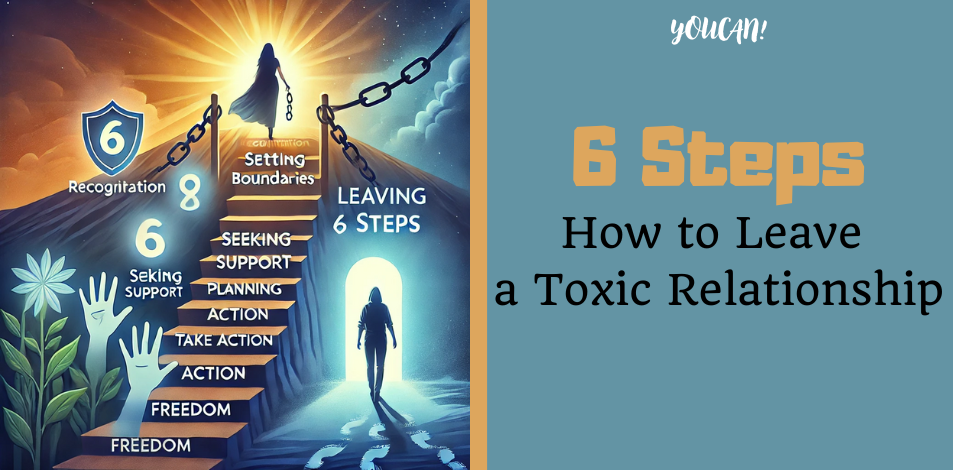
Leaving a toxic relationship is a deeply personal and often challenging decision. However, recognizing that your well-being, mental health, and future happiness depend on this choice is the first step toward freedom. The process of breaking free from a toxic partner can feel overwhelming, but by following a structured plan, you can navigate the emotional and practical hurdles. Here are six crucial steps to help guide you through the process of leaving a toxic relationship.
1. Recognize the Toxicity
The first step toward leaving a toxic relationship is to acknowledge that the relationship is harmful. Toxic relationships are often characterized by emotional manipulation, control, gaslighting, and constant negativity. You might find yourself feeling drained, anxious, or even fearful around your partner. These are signs that the relationship is not healthy.
Related : What to Know If You’re Concerned About a Toxic Relationship
It’s essential to separate your emotions from the reality of your situation. Many individuals in toxic relationships struggle to identify the problem due to manipulation or feelings of attachment. However, recognizing these signs—such as a partner constantly belittling you, isolating you from friends or family, or dismissing your feelings—will help you come to terms with the toxicity.
2. Set Boundaries and Start Protecting Yourself
Once you’ve recognized that the relationship is unhealthy, the next step is to set boundaries. Toxic partners often push these limits, making it difficult to establish emotional or physical space. You need to start protecting your time, your energy, and your well-being. This could mean limiting contact with your partner or refusing to engage in toxic patterns of argument.
Setting boundaries also includes defining your exit strategy. Avoid sharing all your plans with your partner, especially if they have a history of manipulation or aggression. Keep conversations focused on immediate issues rather than dwelling on emotional confrontations. Stay firm with your boundaries and don’t allow them to be manipulated into staying longer than necessary.
3. Seek Support from Trusted People
Leaving a toxic relationship is not something you have to face alone. Surround yourself with trusted friends, family members, or even professional counselors who can provide emotional and practical support. These people can offer you a perspective outside of the toxic dynamic and remind you of your value and the importance of your decision.
Sometimes, leaving a toxic relationship may involve not just emotional separation, but physical safety planning. If there is any concern about your partner’s reaction to your decision, confide in trusted individuals who can help ensure your safety. In certain cases, seeking help from a domestic abuse hotline or shelter may be necessary.
4. Plan Your Exit Carefully
It’s important to have a plan in place before you leave. Toxic relationships can escalate when one person tries to leave, especially if the partner is controlling or emotionally abusive. Think about the logistics: if you live together, where will you go? Do you need to arrange transportation or a safe place to stay for a while?
Related : What Does Egocentrism Mean?
Ensure that your financial and legal matters are in order before making the move. If you share bank accounts or have other joint assets, consider consulting a financial advisor or lawyer for advice on how to protect your interests. If there are children involved, having a legal framework for custody and visitation will be necessary. Taking these practical steps can protect you during a potentially volatile period.
5. Take Action and Break Away
Once your plan is in place, it’s time to take action. This can be the hardest part, but it’s crucial to take that leap. Begin the process of physically and emotionally separating from the toxic partner. This might involve moving out, changing your phone number, and cutting off all contact to prevent them from pulling you back into the relationship.
Remember, it’s common for toxic partners to try and manipulate you into staying. They may apologize, make promises of change, or attempt to guilt-trip you. Stay strong and remind yourself of the reasons why you are leaving. You’ve already decided that this relationship is damaging, and going back will only reinforce the unhealthy patterns.
6. Focus on Healing and Rebuilding Your Life
Once you have left the toxic relationship, the healing process begins. Toxic relationships often leave emotional scars, such as damaged self-esteem, trust issues, or lingering anxiety. Seeking therapy or counseling can be incredibly helpful in rebuilding your confidence and processing the trauma.
Give yourself time to heal and don’t rush into a new relationship until you feel emotionally ready. Focus on rediscovering your interests, passions, and goals. Reconnect with friends and family who may have been distanced during your toxic relationship. Start creating healthy habits that foster self-love, independence, and emotional well-being.
Related : Echoism: The Narcissism Response You Haven’t Heard Of
It’s also important to learn from the experience. Reflect on the signs of toxicity and set clearer boundaries for your future relationships. By understanding what went wrong and what you need in a healthy partnership, you can avoid repeating the same patterns.
Conclusion
Leaving a toxic relationship is never easy, but it’s a vital step toward reclaiming your life and well-being. By recognizing the toxicity, setting boundaries, seeking support, planning your exit, taking action, and focusing on healing, you can successfully navigate this challenging journey. Remember, you deserve a relationship that uplifts and nurtures you, not one that drains and harms you. Taking these steps will guide you toward a healthier, happier future.




